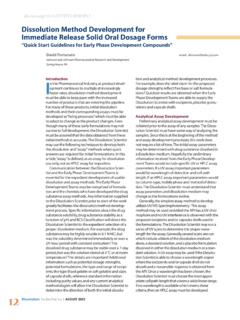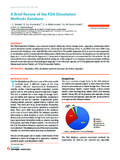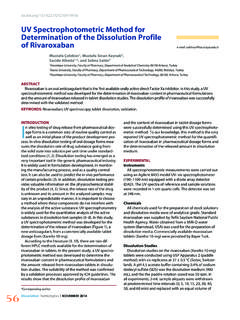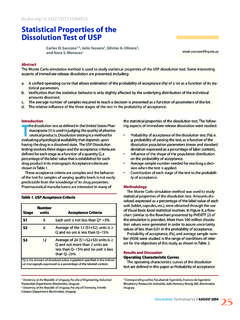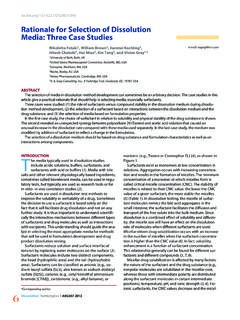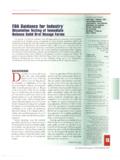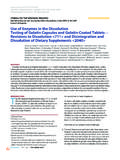Transcription of Analytical Method Selection for Drug Product …
1 Analytical Method Selection for drug Product dissolution Testing Qingxi Wang1, 2, Decheng Ma1, and John P. Higgins1. e-mail: Abstract This article provides an overview of Analytical methods applied to the dissolution testing of various pharma- ceutical products. The benefits and limitations of each Method are discussed with respect to dynamic range, selectivity,extent of automation,efficiency,and robustness. This article presents useful guidance on Analytical Method Selection for pharmaceutical development scientists and quality control personnel who are faced with the challenges of dissolution testing during the drug Product life cycle. Introduction Selection at different stages of drug Product life D. issolution is a characterization test commonly cycle is presented. used by the pharmaceutical industry to guide formulation design and control Product Direct Spectroscopic and quality. Often,it is a required performance test for Spectrophotometric methods solid dosage forms,transdermal patches,and General Overview suspensions.
2 It is also the only test that measures the rate of in vitro drug release as a function of time, UV/VIS methods which can reflect either reproducibility of the Direct UV/VIS spectrophotometric determination Product manufacturing process or,in limited cases, of absorbance has been the traditional Analytical in vivo drug release. The objective of dissolution Method for dissolution testing. A compound will testing,in general,varies during the life cycle of a exhibit absorption in the UV region if it contains one dosage form (1). The primary objective of dissolu- or more chromophores,such as aromatic nitro, tion testing at Phases 0 and I is to establish the disso- azoxy,nitroso,carbonyl,or azo groups. The dynamic lution mechanism. During Phases II and III,the range of UV/VIS absorption is typically from to 2. objective shifts to developing an understanding of absorbance units for commercially available instru- the impact of key formulation/process parameters ments.
3 For quantitation of any given analytes,the on dissolution and an in vitro in vivo correlation desired absorption (A) should be As the (IVIVC). At Product registration and beyond,the goal sample concentration largely depends on the dose, is to identify a quality control (QC) dissolution test the path length,which can be adjusted to achieve Method to verify process and Product consistency. the desired absorption,is often the key parameter. The continual evolution of objectives during the The development of commercial photodiode- drug Product life cycle may require different detec- array UV/VIS spectrometers paved the way for spec- tion methods in order to have effective and efficient tral deconvolution techniques that equipped UV. dissolution tests. spectrometers with the capability of handling multi- In general, Analytical methods used for quanti- component analysis or analysis in UV absorbing fying drug release in dissolution tests can be classi- matrices ( ,excipients).
4 These techniques enable fied into four categories:spectrophotometric, the components of a mixture to be determined chromatographic,mass spectrometric,and poten- simultaneously by optimizing the spectral fit tiometric. This article attempts to provide a compre- between the sample spectrum and a weighted hensive overview of these Method categories, combination of the spectra of the individual compo- highlighting the advantages and limitations of each nents. For example,Anderson et al. (2) reported the Method as applied to dissolution testing. General dissolution testing of capsules and tablets using considerations for Method Selection are discussed, multi-component UV analysis,where interference focusing on five important Analytical parameters: from excipients presents a problem for direct UV. dynamic range,selectivity,extent of automation,effi- analysis. Derivatives of the UV/VIS spectra present ciency,robustness,and compatibility with dissolu- another solution for the elimination of Analytical tion media.
5 Finally,general guidance for Method interferences. The features of the derivative UV. 1 2. Merck Research Laboratories, Pharmaceutical Research & Corresponding author. Development, West Point, PA 19486. 6 dissolution Technologies | AUGUST 2006. Table 1. Advantages and Limitations of NIR, FTIR, and Raman Detection methods Suitable Concentration Technique Key Advantages Key Disadvantages Range Significant interference by aqueous All organic compounds have suitable vibrational FTIR to >100 mg/mL dissolution media. Complex instrumen- bands,adequate sensitivity. tation. Not affected by interference from aqueous systems as FTIR. Simple instrumentation,rugged, Poor sensitivity. Instrument drifts;. NIR 5 1000 mg/mL. fiber-optic probes. All organic and most inorganic requires calibration and maintenance. compounds have suitable vibrational bands. Lowest effect of aqueous media. High degree of molecular information. Suitable probes allow for Poor sensitivity.
6 Complex,non-robust Raman 10 1000 mg/mL. pure measurement of solution phase without instrumentation. interference from the undissolved solids. spectra allow the determination of one or more wave- lengths where the drug compound of interest can be analyzed with zero or negligible absorption from the formu- where k'is a constant depending on the species and the lation matrix (3). Recent developments also include fiber- environment. As the sample absorbance goes beyond optic UV/VIS probes for in situ dissolution testing. An in a 1-cm path length,the relationship becomes nonlinear. outstanding feature of these in situ methods is the capa- In general,fluorescence detection offers superior sensitivity bility to acquire continuous drug release in real time,hence and selectivity compared to that provided by UV detection. providing information on critical kinetic behaviors of the It can be particularly useful for the dissolution testing of active pharmaceutical ingredient (API) such as super-satura- fluorescence-bearing drug products in complex formulation tion,form conversion,intrinsic solubility,and also the entire matrices.
7 dissolution testing with both offline and online kinetic process of the formulation dissolution (4). Though fluorescence detection has been reported (7,8). current fiber-optic UV/VIS methods suffer from inferior Chemiluminescence (CL) detection may be employed for accuracy and variability due to the deposit of particles on dissolution analysis when the analyte lacks a chromophore. the window of the UV/VIS detector,the demonstrated effi- The CL technique is based on the principle that part of the ciency and wealth of information generated in real time chemical energy released in certain reactions is used to make these in situ UV/VIS methods an excellent alternative produce excited species (9). The CL detector is typically 10. to aid dissolution testing at early phase drug development. times more sensitive than the fluorescence detector,and the The direct flow injection analysis (FIA) system coupled with limit of detection (LOD) is 1 pmol for CL and 10 pmol for direct UV detection has been reported recently (5).
8 This fluorescence detector,respectively. Very few applications of technique improves limits of quantitation and detection CL in the dissolution testing of pharmaceuticals have been with minimum consumption of sample solution and can be published (10). applied to dissolution testing for controlled-release dosage forms. IR/Raman methods Fourier transform infrared (FTIR),near infrared (NIR),and Raman spectroscopic techniques have not been reported as Fluorescence and Chemiluminescence methods the direct detection Method of choice for compendial disso- Fluorescence detection can be used if the compound is lution testing since they often require high concentration of naturally fluorescent or can be made fluorescent via deriva- analytes. However,they present another cluster of poten- tization or photoirradiation. Fluorescence is the result of tially powerful online spectrophotometric tools for dissolu- three sequential processes:excitation,intra-system crossing, tion testing.
9 The advantages,limitations,and suitable and fluorescence emission. The difference in energy or sample concentration ranges for FTIR,NIR,and Raman tech- wavelength of excitation and emission is referred to as the niques are summarized in Table 1. Stokes Shift,and is fundamental to the sensitivity of the fluo- Similar to UV/VIS,Beer's law provides the basis for quanti- rescence technique since it allows the detection of emitted tative analysis with IR detection methods . However,nonlin- photons against a low background,isolated from the excita- earities and band overlap can pose great challenges. tion photons. The fluorescent intensity L is directly propor- dissolution of ordinary tablets cannot usually be analyzed tional to the analyte concentration c and the incident by FTIR absorption spectroscopy due to the high absorp- radiant power 0 (6): tivity of water. In addition,the long path length will lead to dissolution Technologies | AUGUST 2006.
10 7. analyzing non-polar compounds. Raman spectroscopy has been developed as the detection technique for lincomycin HCl capsules (14). Mass Spectrometric methods Mass spectrometry (MS) is a spectroscopic tool primarily concerned with the separation of gas phase ions according to their mass-to-charge ratios (m/z).The major components of a mass spectrometer include the sample inlet system,ion source,mass analyzer,and detector. Sample introduction usually involves coupling the mass spectrometer directly to an HPLC,gas chromatograph (GC),or CE;hence,the sample components are separated sequentially prior to entering the mass spectrometer for analysis (15). Many ionization methods Figure 1. dissolution Profiles of Nicotinamide Tablets from ATR-IR Imaging are available,and each has its own advantages and disadvan- and Direct UV Detection tages (16). Commonly used ionization methods include elec- trospray ionization (ESI),atmosphere pressure chemical ionization (APCI),electron impact (EI),chemical ionization (CI), complete absorption of the incident IR light.
